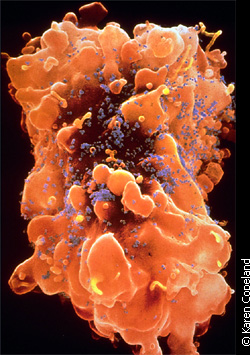| The
forgotten cell
By Kaïla Rosenhek
OTTAWA — One
of the first considerations medical professionals take
into account when treating patients with human immunodeficiency
virus (HIV) is the patient's CD4+ T cell count, as HIV
attacks these cells, primarily, using them to duplicate
the virus.
Treating HIV is difficult, because it
is a lifelong infection, which integrates into a person's
genome, making it impossible to eradicate.

|
| Dr. Karen Copeland has been with
the OHRI for seven years |
While drugs used to treat HIV are very
effective, they are also very costly and very toxic.
HIV can also develop mutations, allowing it to resist
drug treatments. Therefore, new drug treatments must
be developed continuously.
A new approach
Dr. Karen Copeland, a scientist
at the Ottawa Health Research Institute (OHRI), has
spent the last seven years specializing in the study
of CD8+ T cells, which serve an anti-viral function,
known as cell mediated immunity. She is interested in
the inhibitory factors that CD8+ T cells release when
fighting an infection.
Her lab has recently invested time looking
at the ability of CD8+ T cells to be infected by HIV
and how their anti-viral function is affected by the
virus.
"The CD8+ T cells can kill
cells that are infected with HIV or they can release
proteins that can be inhibitory to the virus, so it
doesn’t replicate as well," she says.
| 'Who cares! They're
CD8+ cells and they're not infected in the body.' |
Copeland has found that certain
subsets of CD8+ T cells are more susceptible to infection
than others. She has also found that infection of the
CD8+ T cell increases its anti-viral function.
"My theory is that HIV probably
uses cells bearing the CD4+ receptor in its initial
infection, but if the person starts to develop AIDS
and the CD4+ T cell count is dropping, then that virus
is going to have to adapt itself to affect another type
of cell if it wants to stay alive," she says. "I
want to prove that the other type of cell is the CD8+
T cell."
 |
| HIV, marked by purple spots attached
to T cells |
If she can find and prove that HIV is
entering CD8+ T cells as a different receptor than CD4+
T cells, Copeland says that the receptor could then
be targeted for another type of treatment.
CD who?
Overall, she explains, CD8+ T cells are
largely ignored in research. The functions of other
cells have been studied, but not CD8+ T cells.
Copeland hopes her research of CD8+ T
cell's anti-viral factors will encourage people to take
a bit more interest in these cells. Some people, however,
don't think she should bother looking that closely at
CD8+ T cells.
"Very often they’ll just say,
'Who cares! They're CD8+ cells and they're not infected
in the body'," she says. "But there are publications
out there saying that they are, and some that say that
these cells are frequently infected."
Progress holdup
The major challenge for Copeland, like
many scientists, is getting money. While the Canadian
Institutes of Health Research (CIHR) is currently her
main source of funding, Copeland says the Canadian government
has not increased HIV research funding since 1993.
"They talk about having increased
that money, but a lot of it goes out of Canada and it
is not partnered to research here," she says.
Another problem Copeland faces is staff
turnover. She's gone through five technicians in the
past seven years, which she says restricts her research
capabilities.
"It's a big problem, especially here
in Ottawa, because if technicians are offered a position
within the government at Health Canada for example,
they're going to grab it because they'll make a lot
more money," she explains. "In research, we
can't really pay technicians a huge salary."
In the lead
So far, Copeland says she’s the
only person looking at how infection of CD8+ T cells
affects their anti-viral function. Other scientists
who are in a similar field of research as Copeland are
mainly looking at mutant viruses produced by CD8+ T
cells in people with AIDS.
But Copeland says she wants to continue
to focus on which cells HIV is attaching to first, to
target for treatment before AIDS develops.
|
| Drug
Treatment Resistance
The Canadian HIV Strain and Drug
Resistance Surveillance Program monitors and assesses
HIV strains and the rate of HIV drug resistance
among newly diagnosed and untreated individuals
in Canada, both male and female, from different
age groups, and ethnicities.
The overall prevalence of primary
drug resistance to at least one antiretroviral
drug is 8.6%.
The overall prevalence of multidrug
resistance to two or more types of antiretroviral
drugs is 1.4%.
The prevalence of primary drug
resistance is similar to what has been observed
in other countries where highly active antiretroviral
treatment (HAART) is widely used.
Source: Centre for Infectious
Disease Prevention and Control |
| AIDS
epidemic
An estimated 3.1 million people
died from the AIDS virus last year and another
4.9 million people became infected.
Just over 1 million people are
currently receiving treatment.
The approximate 5 million people
infected by HIV globally in 2005 represents the
highest jump since the first reported case in
1981, taking the number living with the virus
to a record 40.3 million.
Cases of HIV infection are on
the rise in Canada and by the end of 2004, almost
58,000 people were living with HIV. Over the past
five years, the rate of new cases of HIV infection
in Canada has increased by 20 percent.
The director of the Global Fund
to Fight AIDS, Tuberculosis and Malaria, says
that despite limited successes, HIV-control efforts
are underfunded. International donors supply roughly
$5 billion of the $20 billion needed annually
for AIDS programs.
Source: Foreign Affairs
Canada |
|